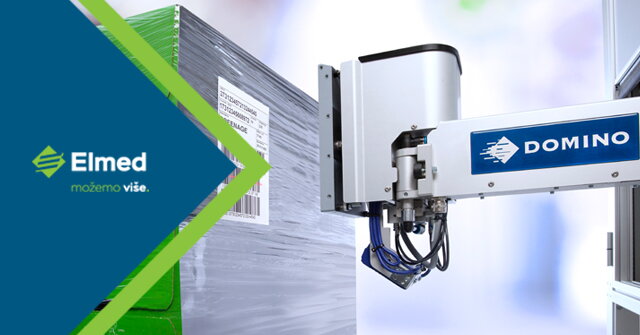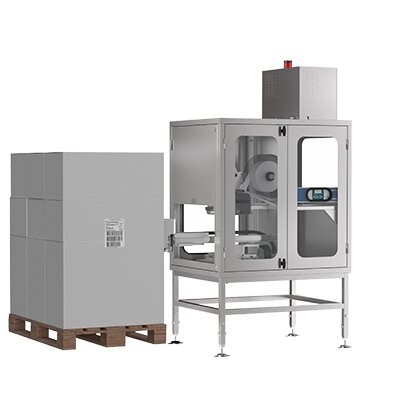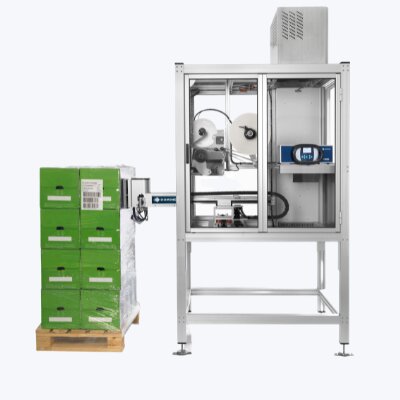How to overcome inefficiencies with your pallet labelling process

Pallet labelling is the process of labelling your tertiary packaging – most often a pallet – with two or more barcodes for traceability as products move through the supply chain.
Why is pallet labelling important?
Pallets must be labelled correctly with legible and clear codes containing details of the product and its quantities, including supplier details, serial numbers, batch numbers and more. This is for traceability purposes within a warehouse or Distribution Centre where scanners will be required to read these codes quickly and without fault. When printed labels are applied correctly on multiple pallet surfaces, they are easier to scan; therefore improving logistical efficiency, inventory control, and saving both time and money.
Common problems with pallet labelling
For efficient pallet labelling, labels must be perfectly printed and correctly placed onto each pallet at speed. To reach this efficiency, automating the labelling process is vital.
However, many companies still manually label their stock which can be a highly inefficient process. For example, warehouse workers might unload a pallet, get off the forklift, walk over to a computer to print off the labels, walk back to the pallet to apply the labels by hand, hop back onto the forklift and move the pallet into storage or onto a lorry for transportation.
This method leads to a lot of wasted time that affects final margins. Not to mention, applications by hand are generally not square and may not meet the GS1 height guidelines, causing headaches further down the line.
If a label is in the wrong place and doesn't meet these guidelines, a scanner can't read it. Your stock could therefore get rejected if scanned incorrectly, leading to more time lost and potential fines.
Key challenges of pallet labelling
The volume of pallets produced requires a labelling system that will print and apply labels correctly every time, keeping production costs down and ensuring goods face no problems throughout the supply chain.
However, GS1 standards aside, perhaps the most critical challenge is ensuring that your labels are compliant with your customers and can integrate with their existing systems. It's vital to know what your customers require and how to label your pallets to suit them efficiently.
As such, you must be versatile in how many labels you apply to the pallet. The GS1 guidelines only show what most customers need. While some may require only one or two, some could need three or more.
To meet most guidelines, you simply have to apply labels in the correct locations, ensuring they are square-on and without any uneven edges or creasing. Automating your pallet labelling process will allow for accurate placement every time.
Further considerations for pallet labelling
While it can be a challenge to ensuring clear, uniform labelling, there are many other external factors in the process to consider.
For instance, the environments your tertiary packaging will go through can also affect the labelling process. Packaging in a wet environment will have different requirements compared to a dry environment.
For example, wet beverage sites will need stainless steel cabinets to protect them from the humidity (see below).

Aluminium cabinets however are sufficient for dry sites (see below).

Temperature can also be an issue, so you may need climate control kits or heaters to ensure that a suitable climate is maintained at all times.
As these labels contain a lot of information, it's essential to consider both your and your customers' software capabilities. Controls from the pallet labeller to the palletiser must be able to send and receive signals efficiently in order to stop the pallet and move it along once the label is applied. Elmed has produced a software module called LoupeCode for automatic marking of the collective packaging and pallets, according to the GS1 standards. The software is used to automatically generate data, related to the collective packaging label, as well as the sending that data to the printer. It has the ability to archive all data sent to the printer in the desired format as well as the ability to generate the reports, related to the submission of collective packaging to the warehouse, as well as all the sent data within the labels of the collective packaging.
The conveyor systems used in the different stages of a pallet's journey may differ in height and speed, as well as the number of stops it makes as it moves through the palletiser and a stretch wrapper. As such, a flexible and easily adjustable system is crucial.
To tackle these critical issues and avoid making costly mistakes, you need a versatile pallet labeller that you can configure to meet GS1 and customer standards with ease.
The solution – Domino M-Series
Powered by Domino's uniquely intelligent technology, I-Tech, the Domino M-Series labelling system provides clear codes for systematically printing and applying perfect labels to your secondary or tertiary packaging.
The M-Series can place multiple labels per pallet with 1 or 2 stops with various label sizes. It adjusts to suit your needs and easily integrates into your existing production line. With its robust printer with 600m of ribbon and label roll, which are synchronised to be replaced simultaneously, and an intuitive UI touch screen, you can breeze through the pallet labelling process in a fraction of the time compared to applying labels manually.
For more information about how the Domino M-Series can speed up your package labelling and reduce overall costs, contact us today.
